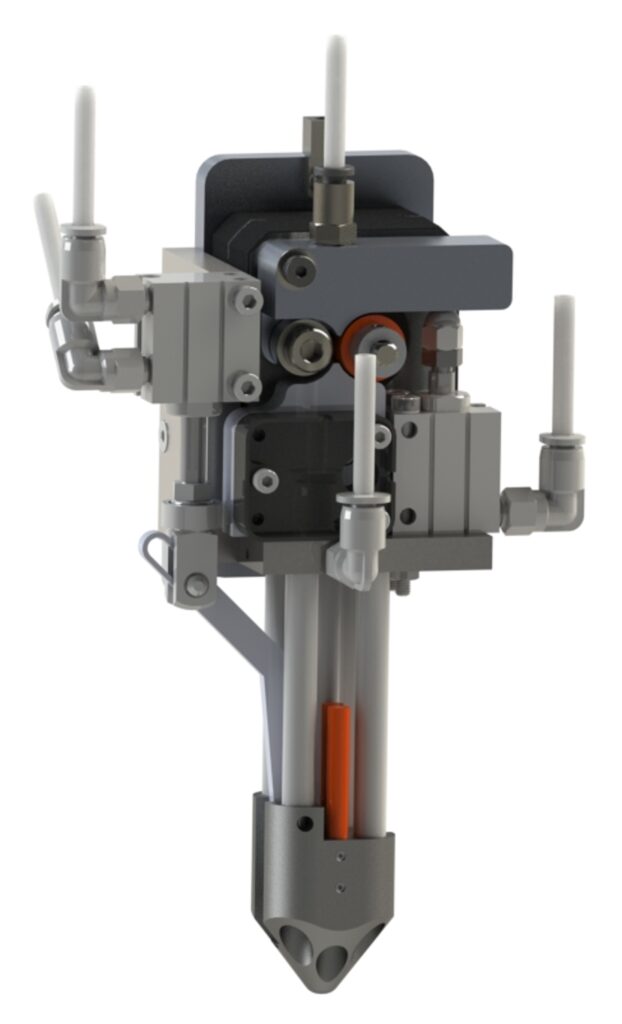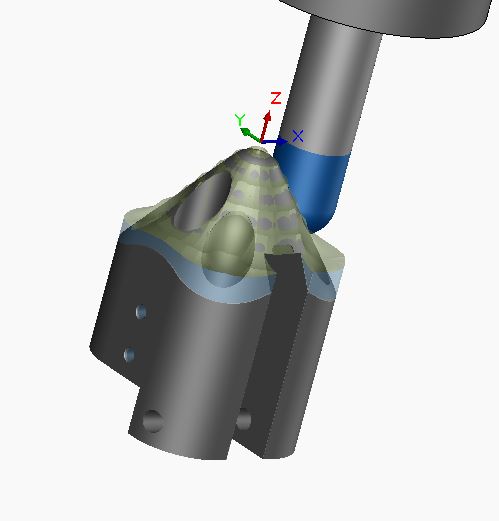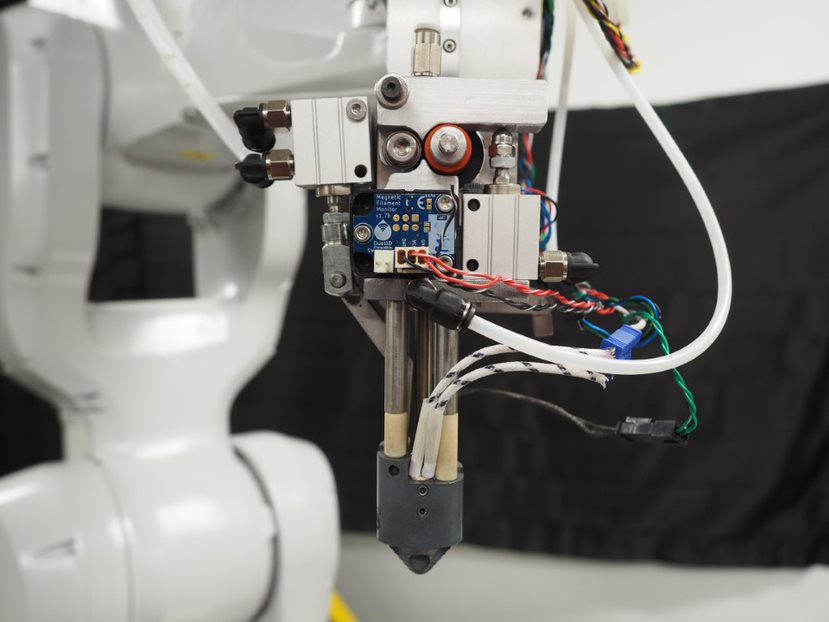Project Category: Mechanical

The CFP-500: A 3D Printhead for Composite Materials
About our Project

The CFP-500 is a composite filament 3D printhead mounted on a 6-axis robotic arm. The potential to transform manufacturing and design processes has supercharged demand for rapid prototyping with increased strength and geometric intricacy.
To do this, our printhead combines two technologies: composite filaments (polymers reinforced with continuous carbon fibers) and 6-axes of printing flexibility by mounting the printhead on a robotic arm. Together, composite filaments and 6-axes of freedom accomplish two goals. They combine the strength of carbon fiber, and enable printing over double-curved surfaces and around metallic inserts.
Real-world applications include custom prosthetics, bike frames, drone chassis and other applications requiring components with ultra-high strength-to-weight ratios.
We invite you to stop by booth 6 in the Atrium at the Schulich School of Engineering on April 5th between 10:00 am and 12:30 pm to see the CFP-500 in-person!
Design Details
DESIGN OVERVIEW
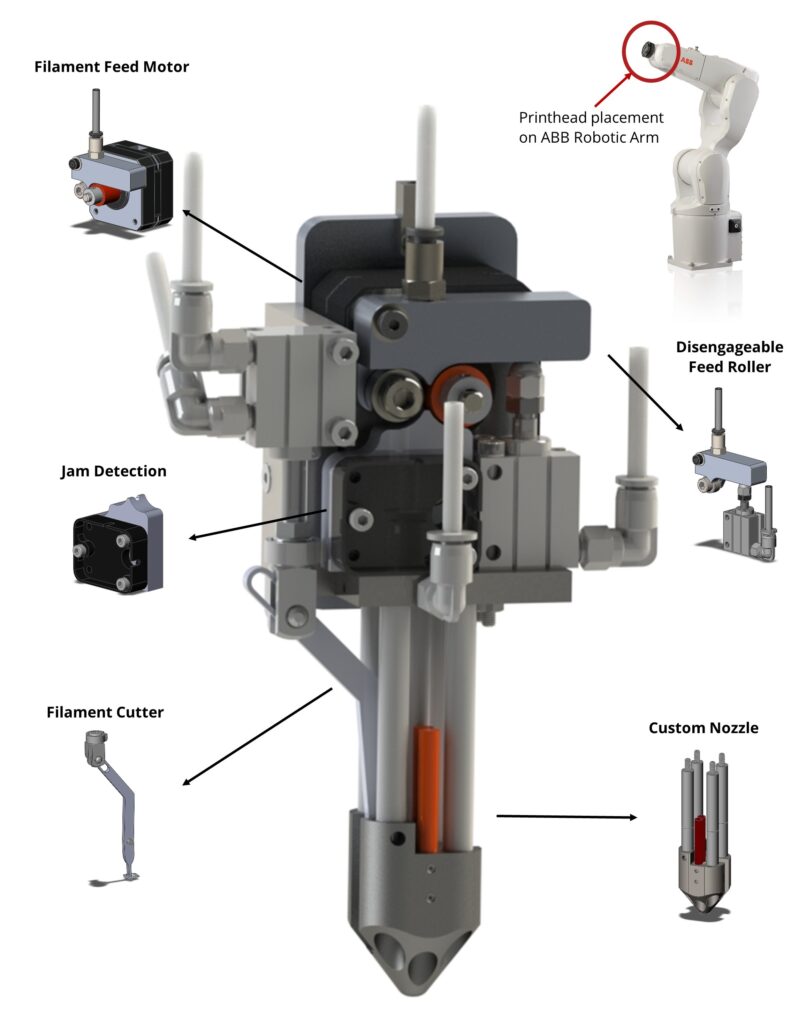
The CFP-500
Filament Feed Motor extrudes custom carbon fiber filament.
Disengageable Feed Roller automatically engages and disengages the filament feed system, enabling greater design flexibility.
Jam Detector pauses prints in the event of filament jams or filament run out.
Filament Cutter isolates individual filament paths with a minimum cut length of 10 mm.
Custom Tapered Nozzle enables printing in tight spaces and around metallic inserts.
FEATURES
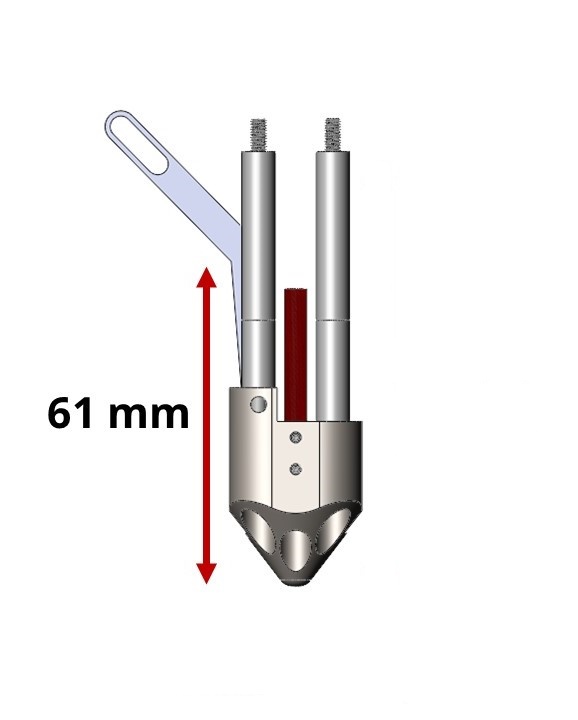
Effective Length
The CFP-500 boasts an effective nozzle length of 61 mm, separating the printhead body from the nozzle tip. The custom nozzle enables the deposition of filament around metallic inserts and over double-curved surfaces!

Cut Length
Unlike traditional polymer filaments such as PLA and ABS, our continuous carbon fiber filament must be cut to isolate individual filament paths. Shorter cut lengths enable greater design flexibility. The CFP-500 cuts filament segments as short as 10.5 mm! This short cut length enhances design freedom and geometric intricacy of components.
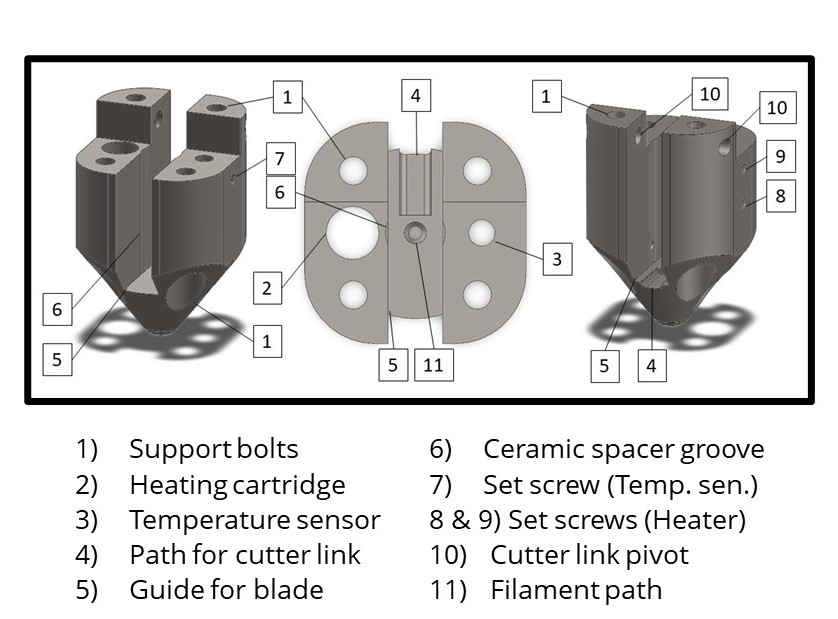
Custom Tapered Nozzle
Our cutting-edge nozzle incorporates a ceramic cutting blade, a 40W heating cartridge, and a PT1000 temperature sensor. This H13 tool steel nozzle was CNC’d and heat treated in a vacuum furnace to increase its hot hardness, as it will be operating at temperatures of up to 500°C.
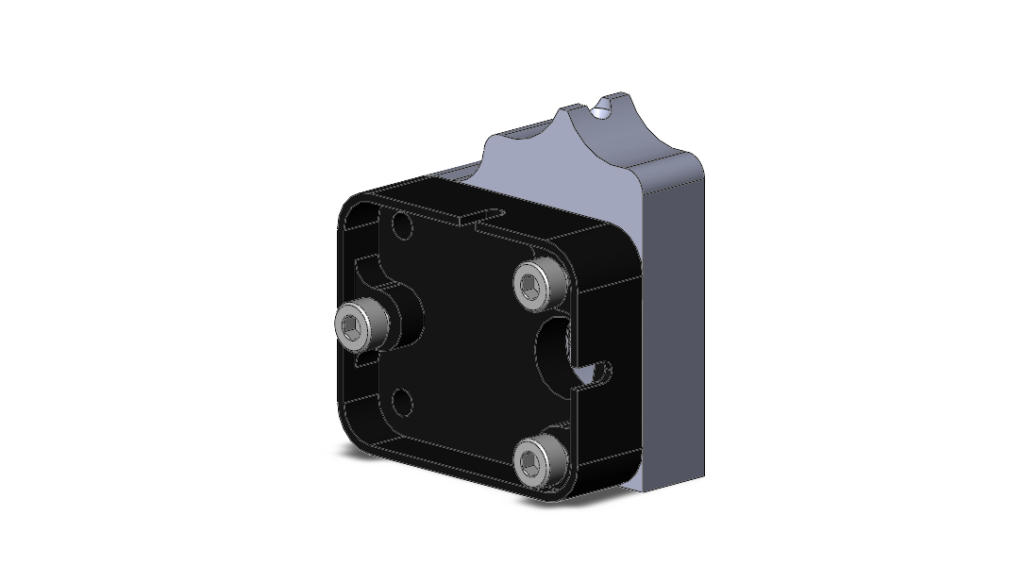
Integrated Jam Detection
The integrated jam detection system senses and reports filament jams. Once filament runout or a jam has been sensed, the jam detector tells the controller to pause the print. This is important for:
• Preventing filament waste
• Reducing the likelihood of failed parts
• Saving time
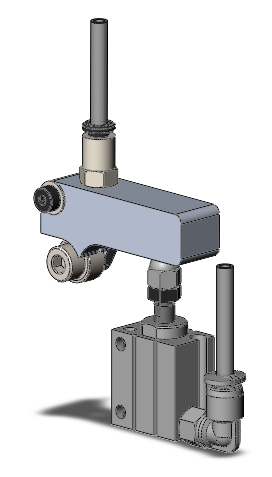
Disengageable Feed Roller
The pneumatically-actuated disengageable feed roller automatically engages and disengages the filament feed system. The single-acting linear pneumatic actuator outputs up to 70 N of force to grip the composite filament.
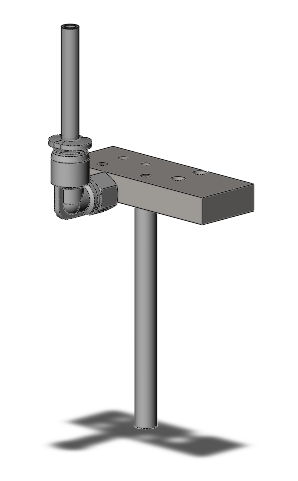
Novel Cooling System
Unlike traditional 3D-printers, the CFP-500 does not use a heat sink or fan! A single tube supplied with compressed air keeps the filament from melting before reaching the 500°C nozzle. The heat sensitive components are protected by a physical separation and ceramic spacers ensure that the heat remains at the nozzle.
HOW OUR INNOVATIVE DESIGN ADDRESSES PRACTICAL ISSUES
The emergence of additive manufacturing technologies in the 1980s paved the way for the development of contemporary 3D printers. These technologies are revolutionizing engineering design and have the potential to transform the manufacturing industry.
New composite filaments are emerging, including towpreg filaments, which are thermoplastics impregnated with continuous carbon fibers. These composite filaments have an ultra-high strength-to-weight ratio. However, the printing of these composite filaments requires specialized 3D printheads. As such, advances in 3D printing technology are critical to the realization of these benefits.
This capstone focuses on designing and building an advanced 3D printhead for composite filament printing. This undertaking is based off an existing 3D printhead that was designed by PhD student Nicholas Elderfield. Our printhead minimizes the filament cut length, allowing shorter filament paths, and leading to greater flexibility in the designs and G-code. Furthermore, the printhead is mounted on a 6-axis robot arm to maximize overall component strength.
Furthermore, the configuration of this printhead enables the reinforcement of internal ribbing and other inserts with carbon fiber filament for high performance applications, such as the automotive and aerospace industries. Ultimately, the aim is to print composite parts with strength that is comparable to injection molded and compression molded components. Enabling the additive manufacturing of complex functional components is expected to offer low-cost prototyping, replacement parts, and small series production.
WHAT MAKES OUR DESIGN SOLUTION EFFECTIVE
The CFP-500 is effective because it is designed to enhance the effect of the technologies it combines.
Printing continuous carbon fiber infused filaments increases component strength, but can be a limitation if the cut length is long as it limits the scope of components that can be printed. The CFP-500 minimizes this cut length making it more effective.
Mounting the printhead on a robotic arm allows for the printing over double curved surfaces and around metallic inserts. However, this is severely limited if the nozzle shape and size impact the ability of the printhead to enter small spaces. The CFP-500 maximizes the effective length of the nozzle allowing it to reach into small spaces and enhance the effect of having 6-axes of freedom.
Additionally, the project scope determined clear guidelines that would need to be achieved to ensure that the design solution was effective. By achieving or coming close to all of the success criteria as shown below, the design solution has proven to be effective.

HOW WE VALIDATED OUR DESIGN SOLUTION
The CFP-500’s designs were validated through extensive engineering analysis and in-lab testing. The team worked closely with the project stakeholders to ensure smooth integration of the printhead with the robotic arm. By performing engineering calculations, seeking and receiving feedback, and conducting tests, the printhead evolved into a functional prototype. Key testing and engineering analysis is highlighted below.
Analysis & Testing
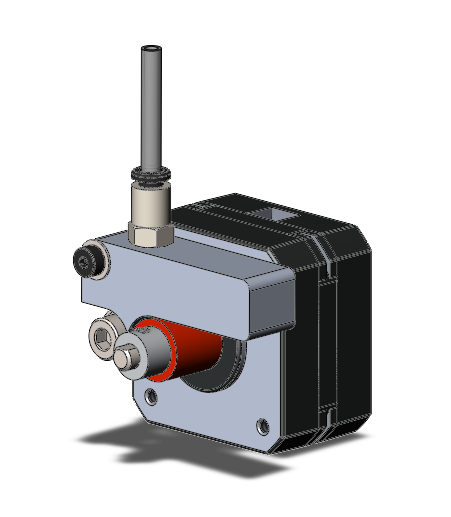
Feed Motor
To evaluate if the 25 mm pancake stepper motor was a viable option, a 40 mm NEMA17 stepper motor was current limited to output the same torque as the 25 mm pancake motor. Lab testing confirmed that the reduced torque was sufficient to extrude the composite filament. Thereby, validating our motor selection.
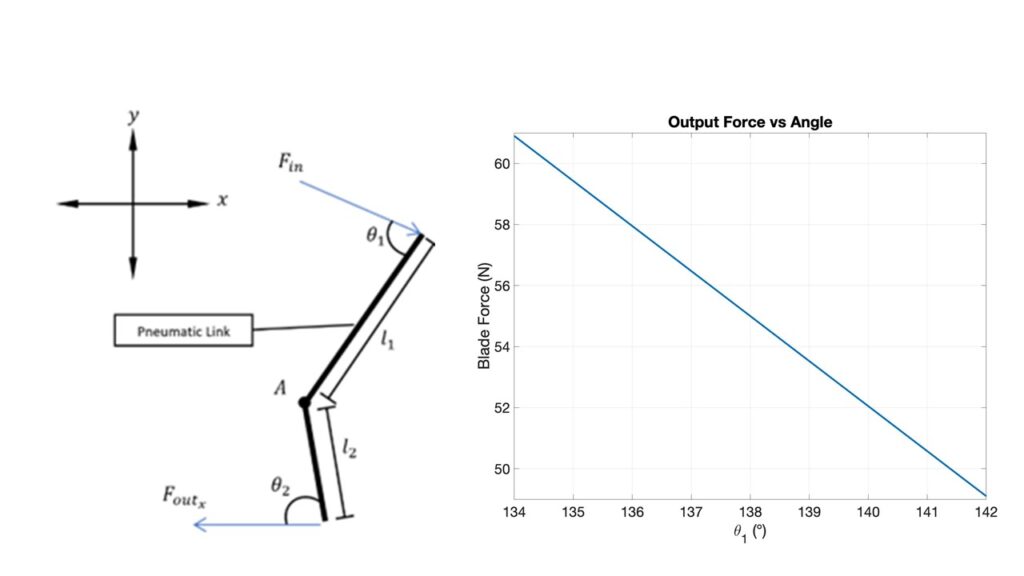
Cutting Mechanism
Kinetic and kinematic analysis of the cutting link was crucial to ensuring that sufficient force was supplied to cut the filament. The analysis on the left shows the kinetic model of the pneumatic link and a comparison between the angle of the cutting link and the cutting force applied. These calculations validated that the cutting force supplied is adequate.
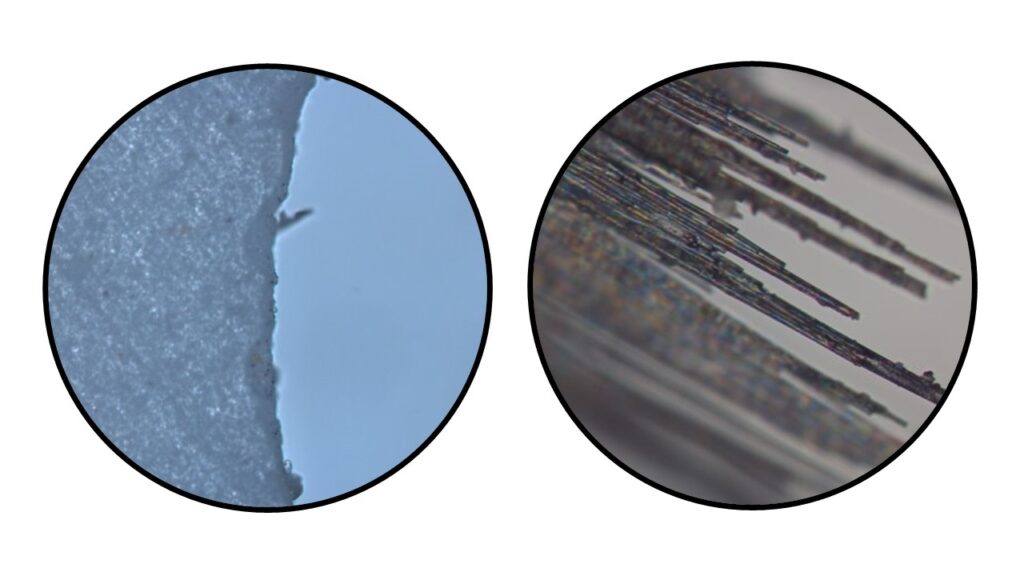
Microscopy
The photo on the left shows the machined slot in the cutting blade. The smooth finish shown serves to minimize wear on cutting link.
The photo on the right shows the edge of cut filament. The clean cut with minimal fraying of filament demonstrates that the cutting mechanism is effective.
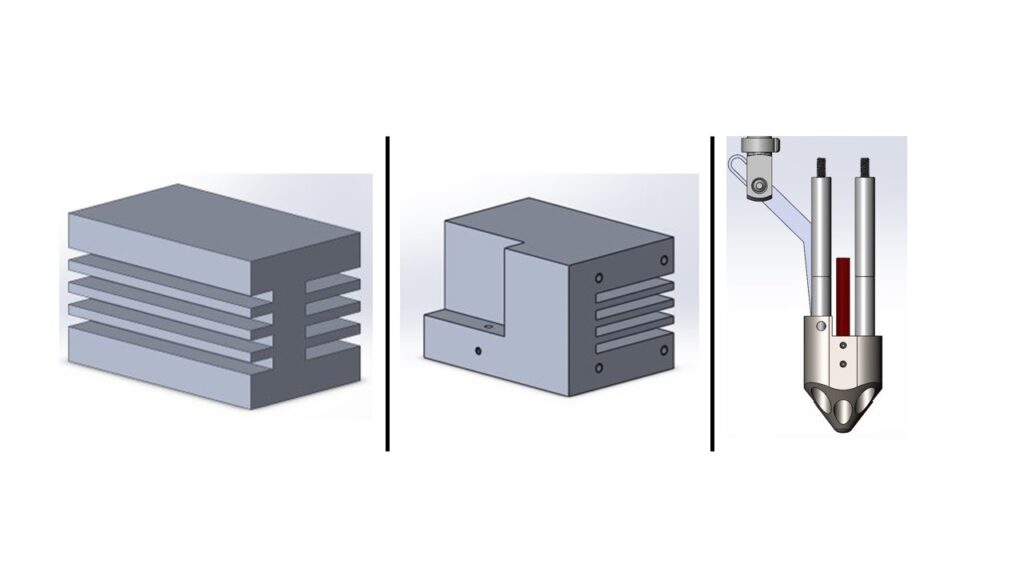
Heat Dissipation
Standard 3D printers use a heat sink and fan to remove heat and protect heat sensitive components. On the left, the progression of heat sink designs for the CFP-500 can be seen. Due to the nozzle’s unique length, it was determined that this distance could be optimized as a heat break, removing the need for a heat sink. This hypothesis was validated using a series of heat transfer calculations. Through the CFP-500’s first prints, the heat break has worked effectively to dissipate heat and protect the heat sensitive components.
FEASIBILITY OF OUR DESIGN SOLUTION
The feasibility of the design solution was demonstrated in the manufactured product. After the design process was completed, the CFP-500 was fully manufactured. While elaborate test prints were not able to be completed, simple test prints were conducted, and the major systems all proved to be functional.




Meet the Team

Noreen Abdelwahab
Noreen’s areas of interest are control systems and aerospace engineering. She completed her internship at SKF Magnetic Bearings. She will be pursuing a thesis-based master’s researching novel control systems for hybrid rockets after graduation.
Project Work
Noreen served as the project manager for this project, taking the lead on managing the overall timeline and project. Additionally, Noreen was primarily responsible for the design of the jam detection system as well as supervising the integration of the overall assembly.

Dawson Alexander
Dawson is currently finishing a mechanical engineering degree with a biomedical engineering specialization. He also had the opportunity to complete a 12-month internship in the Oil and Gas industry during his undergraduate degree.
Project Work
Dawson’s primary role was external communications. Additionally, Dawson was primarily responsible for design of the cooling system and took the lead on technical writing.

Samantha Mauthner
Samantha is currently finishing a mechanical engineering degree with a manufacturing engineering minor. She also had the opportunity to complete a 16-month design internship at Garmin working with wearable technology.
Project Work
Samantha was jointly responsible for the design of the filament cutting mechanism and nozzle. Additionally, she served as the meetings and manufacturing manager.

Bethlehem Mentie
Bethlehem is a final year mechanical engineering student with a minor in mechatronics. Beth is passionate about novel product design and crafting innovative solutions to challenging problems.
Project Work
Bethlehem was jointly responsible for the design of the filament cutting mechanism and nozzle. Additionally, she served as our internal communications officer.
Partners and Mentors
We’d like to express our sincere gratitude to the Schulich School of Engineering and the ENME 501/502 course coordinators and instructors. We’d like to especially thank Dr. Alex Ramirez-Serrano and Danny Wong for their design feedback and suggestions.
We’d also like to thank our project sponsor Dr. Joanna Wong and the Laboratory of Engineering Materials. PhD students Nicholas Elderfield and Hussam Tawfik have provided tremendous technical support for this project. Their continuous support and technical expertise have been highly valued.
Finally, we’d like to thank Sean Mason from the Student Machine Shop for providing valuable insight about the machinability of our designs.
Our Photo Gallery
